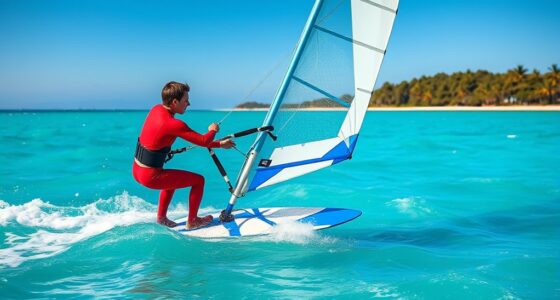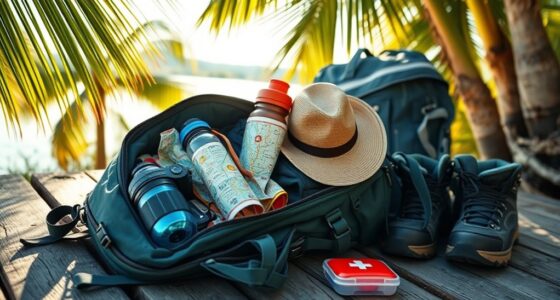To choose the right stand-up paddleboard, consider your skill level, water conditions, and what activities you’ll do most. Beginners should opt for wider, more stable boards, while experienced paddlers may prefer narrower, performance-oriented designs. Think about the type of board—whether inflatable, all-around, or touring—and its shape, size, and materials. Make sure it can support your weight and gear comfortably. If you keep these factors in mind, you’ll find the perfect match; more tips await.
Key Takeaways
- Match the board type and shape to your intended activities, such as all-around, touring, or yoga.
- Consider your body weight and water conditions to select the appropriate size and stability features.
- Evaluate your skill level to choose a board with suitable stability, responsiveness, and handling characteristics.
- Check water environment conditions and select a board designed for calm or rough waters accordingly.
- Prioritize safety features and accessories like leashes, PFDs, and durable materials for secure paddling.
Understanding Different Types of Paddleboards
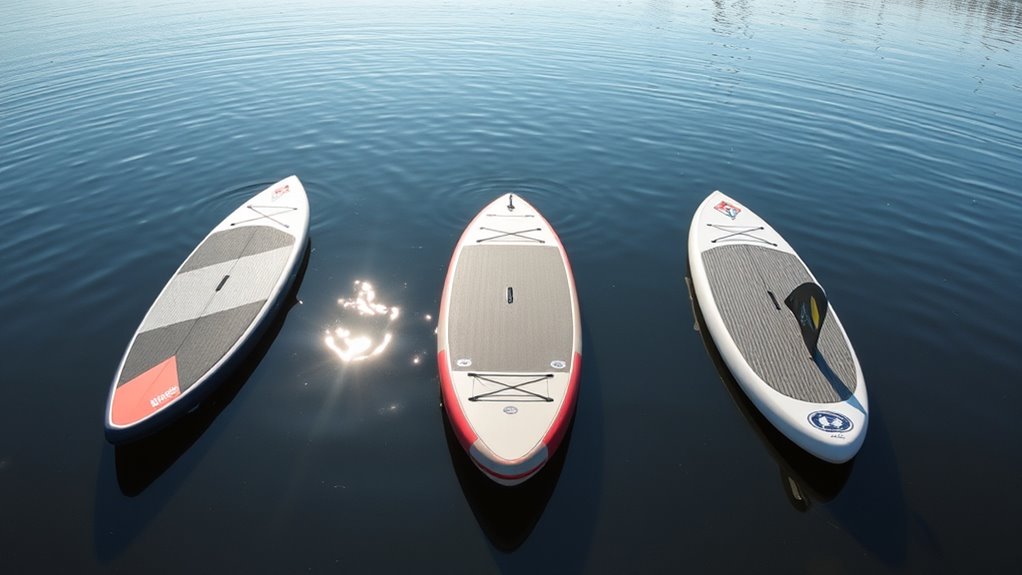
Have you ever wondered why there are so many types of paddleboards? It all comes down to paddleboard design and your specific needs. For example, all-around boards are versatile, great for beginners, and suited for various activities. Touring paddleboards are longer and narrower, ideal for long-distance paddling and speed. Inflatable paddleboards offer portability and are perfect for travel, while rigid epoxy boards provide stability and performance for more advanced paddlers. Your choice also depends on paddleboard accessories, like fins, leashes, and storage racks, which enhance your experience. Understanding the different types helps you select a board tailored to your activity level and preferences. Additionally, selecting the right paddleboard can be influenced by the material composition, which affects durability and weight. Considering the environmental impact of your paddleboard can help you make more sustainable choices. Incorporating natural materials into your paddleboard can also impact its sustainability and overall environmental footprint, aligning with eco-friendly practices. Furthermore, understanding how yoga principles can be integrated into paddleboarding can enhance your balance and mindfulness during your activity. A well-chosen paddleboard will also take into account the filtration systems used in manufacturing, which can influence the board’s eco-friendliness.
Selecting the Right Size for Your Body and Skill Level

Choosing the right paddleboard size depends on your body weight, skill level, and the water conditions you’ll encounter. A board that’s too small or large can make balancing and paddling more difficult. Consider these factors carefully to find a board that offers stability and control for your experience. Additionally, understanding the cost of building a tiny house can help you plan your budget effectively if you’re considering a mobile or stationary setup for your paddleboarding adventures. When selecting a paddleboard, it’s also helpful to consider Vetted electric bike conversion kits, as they highlight the importance of reliable and suitable equipment to enhance your overall outdoor experience. Evaluating vertical storage solutions can also be beneficial for storing your gear efficiently and keeping your space organized. Recognizing the proper paddleboard dimensions ensures you choose a size that complements your body and enhances your paddling efficiency. Moreover, exploring crochet styles for locs can inspire creative ways to personalize your gear and accessories for outdoor activities.
Body Weight Considerations
Ever wonder how your body weight influences the right paddleboard size? Your weight affects stability, glide, and maneuverability. Generally, heavier paddlers need larger boards to stay balanced and comfortable on the water. If your board is too small, you’ll struggle with stability; too large, and paddling becomes harder. Consider your weight when choosing the board’s length and width—heavier paddlers benefit from wider, longer boards. Proper paddleboard maintenance helps prolong your board’s lifespan, especially if you store it correctly in a cool, dry place. Storage conditions impact the board’s performance and durability, making it essential to protect your investment. Additionally, understanding market growth projections can help you select a board designed with innovative features that suit your needs. Regularly inspecting your paddleboard and performing board care can prevent damage and extend its usability. Ensuring proper storage practices can also significantly affect the longevity of your paddleboard, preventing warping or damage from environmental factors. Using professional guidance when selecting your board can further ensure you make the best choice based on your body weight and skill level. Recognizing investment considerations can help you choose a paddleboard that offers better value and durability over time. Matching your body weight with the right size ensures a smoother, more enjoyable paddling experience and easier paddleboard maintenance over time.
Skill Level Compatibility
Your skill level plays a crucial role in selecting the right paddleboard size, as it directly impacts your comfort and confidence on the water. Beginners should opt for wider, more stable boards that offer better balance and easier paddleboard storage options for practice and transportation. As you advance, you can try narrower, more agile boards that improve maneuverability. Proper paddleboard cleaning and maintenance are essential to keep your board in good condition, especially if you’re learning to handle different water conditions. Smaller or less stable boards may require more skill, so choose a size that challenges you without feeling overwhelming. Recognizing water conditions can help you select a board that performs well in various environments. Understanding board stability and myelination influences brain efficiency and can also aid in developing better paddleboarding techniques as your skills progress. Being aware of environmental factors such as wind and currents can further enhance your safety and performance on the water. Additionally, choosing a board with the right construction materials can affect durability and weight, making it easier to handle in different conditions.
Water Conditions Suitability
The water conditions where you’ll paddle greatly influence the ideal board size for your body and skill level. If you paddle in areas with strong water currents or high wave heights, you’ll want a more stable, larger board to maintain control. Conversely, calm waters with gentle wave heights allow for a shorter, more maneuverable board suited for advanced skills. Consider these factors:
| Water Currents | Wave Heights | Recommended Board Size |
|---|---|---|
| Strong | High | Longer, wider |
| Moderate | Moderate | Medium-length |
| Calm | Low | Shorter, narrower |
Understanding the water conditions can help you select a paddleboard that enhances your overall paddling experience. Recognizing how vibrational energy affects your confidence and enjoyment can also guide your choice of equipment and techniques for an optimal experience. Additionally, considering the tuning of your board can improve stability and performance across different water scenarios. Properly retrofitting your board with the right features can further optimize performance in various conditions.
Considering Board Shapes and Their Purposes

Choosing the right board shape is essential because different designs are built for specific activities and skill levels. Your choice of board shapes directly impacts your paddling experience and success on the water. For example, wider and more stable paddleboard purposes are ideal for beginners or those focusing on yoga and relaxation, offering balance and ease of use. Narrower, more streamlined shapes are better suited for racing or touring, providing speed and efficiency. All-around paddleboards combine features to handle multiple purposes, making them versatile options. Understanding the purpose behind each board shape helps you select a design that matches your goals, whether you’re cruising, exploring, or racing. Picking the right paddleboard shapes ensures you enjoy your time on the water while improving your skills.
Choosing Materials for Durability and Performance
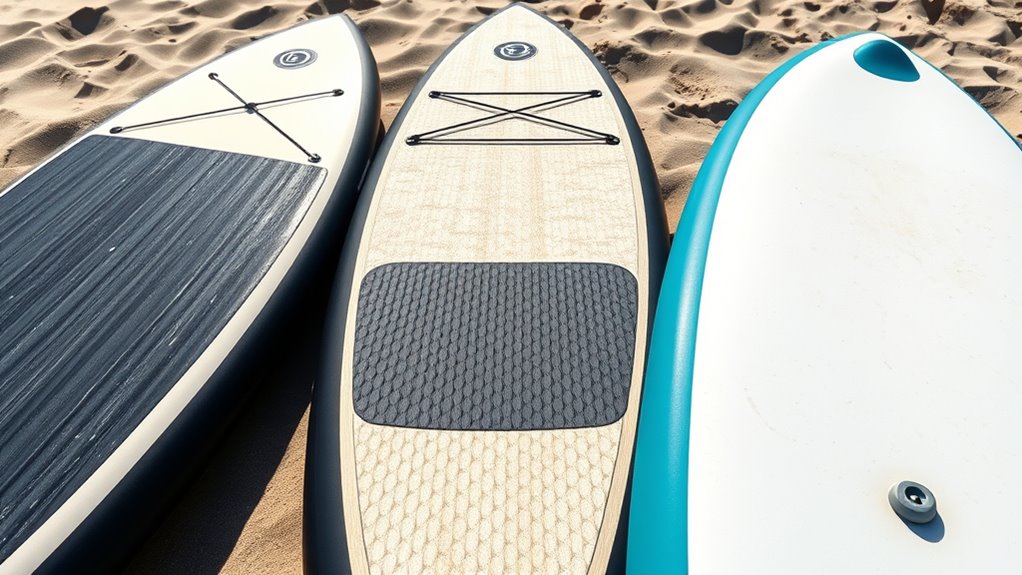
Selecting the right materials for your paddleboard is essential because it directly affects the board’s durability and performance on the water. Durable materials ensure your board withstands bumps and scrapes, while performance-focused materials improve speed and maneuverability. When choosing, consider eco friendly materials that reduce environmental impact without sacrificing quality. Look for boards made with lightweight, strong cores and reinforced layers to enhance longevity. Incorporate paddleboard accessories that complement your material choice, like non-slip decks or fin systems, for better control.
- Use eco friendly materials like recycled foam or sustainable epoxy resins
- Opt for reinforced layers for increased durability during rough use
- Choose lightweight cores to improve maneuverability and reduce fatigue
Assessing Stability and Balance Features
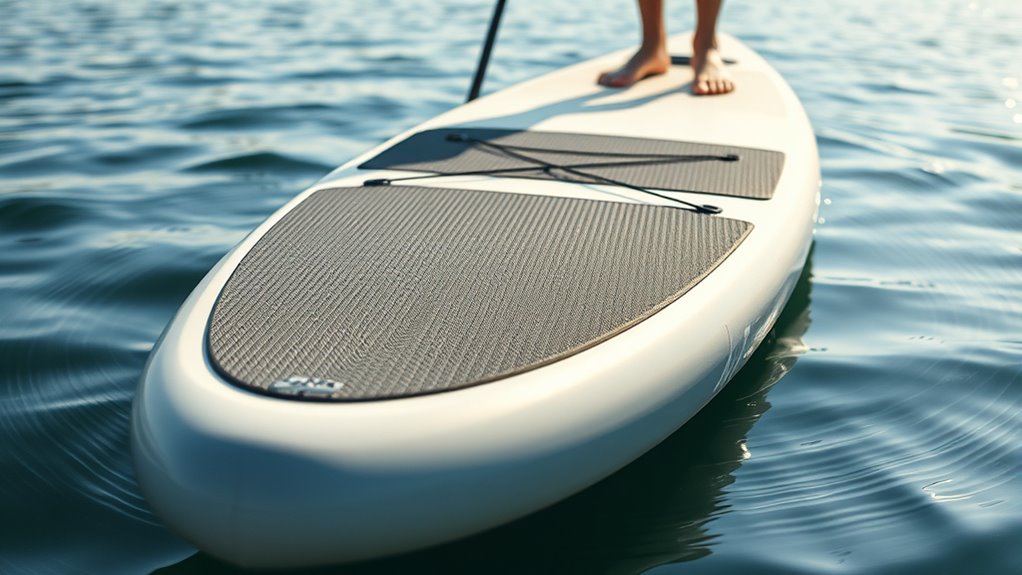
When evaluating a paddleboard’s stability and balance features, focus on its shape, width, and volume. A wider board offers better stability, especially for beginners, while a lower volume improves balance. Check for anchor points; they help secure gear without affecting your stance. Deck padding provides grip, reducing slips and increasing confidence on the water. Use this table to compare features:
| Feature | Benefits |
|---|---|
| Shape | Influences maneuverability and stability |
| Width | Affects balance and ease of paddling |
| Volume | Determines buoyancy and weight support |
Prioritize these features based on your skill level and intended use to find a board that maintains stability and balance during your paddling adventures.
Evaluating Weight Capacity and Portability

Ensuring a paddleboard can handle your weight and is easy to transport is essential for a satisfying paddling experience. Check the manufacturer’s recommended weight capacity to avoid overloading, which can affect stability and performance. Consider how the board’s weight distribution influences your balance and comfort on the water. Portability depends on factors like size, weight, and storage options, so choose a board that’s manageable for you to carry and store. Keep these in mind:
- Evaluate storage options for easy transport and storage
- Confirm weight capacity matches your weight and gear
- Assess how weight distribution affects stability and handling
Identifying Essential Features and Accessories
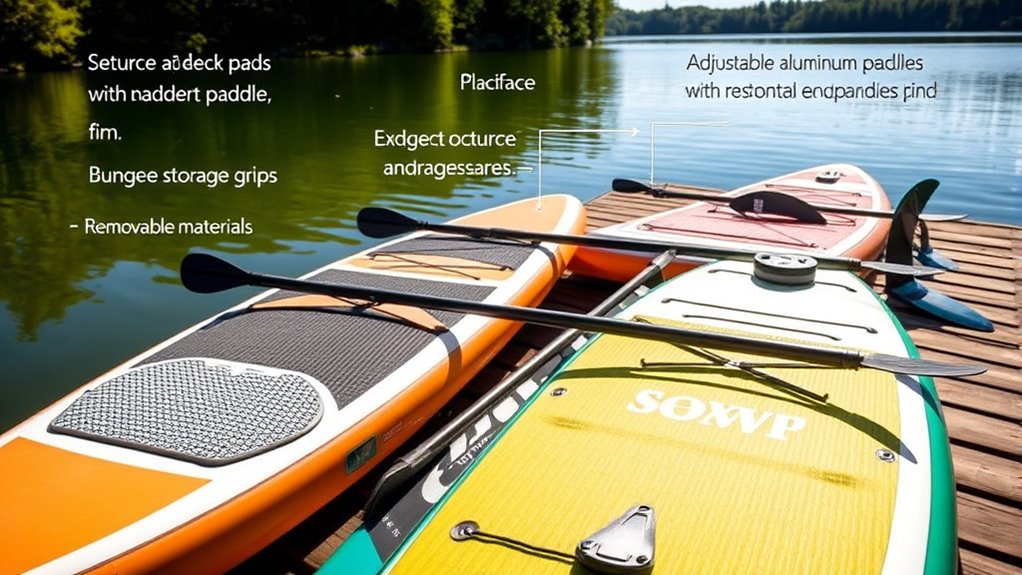
When choosing a paddleboard, you need to consider its material and how durable it is for your typical use. Safety accessories like a leash and personal flotation device are essential for your protection on the water. Also, think about the size and weight of the board to ensure it’s easy to transport and suits your skill level.
Board Material and Durability
Choosing a stand-up paddleboard with the right material is essential for durability and performance. The board material influences how well your paddleboard withstands impacts, weather, and regular use. Common options include epoxy, inflatable, and composite materials, each offering different durability levels. For example, epoxy boards are lightweight and sturdy, ideal for durability in rough conditions. Inflatable boards are highly portable but may be less durable against sharp objects. When selecting, consider how often you’ll use the board and your typical environment. Look for features like reinforced rails or textured surfaces that enhance durability.
- Check the board material for impact resistance
- Ensure the core and deck are reinforced
- Look for high-quality, UV-resistant coatings
Essential Safety Accessories
Having the right safety accessories is essential for a safe and enjoyable paddleboarding experience. Paddleboard accessories like a leash, personal flotation device (PFD), and a whistle are key safety gear that protect you in emergencies. A leash keeps you connected to your board, preventing it from drifting away if you fall. Wearing a PFD ensures buoyancy and safety in case of fatigue or unexpected conditions. A whistle offers a simple way to signal for help if needed. Additional safety gear, such as a waterproof communication device or a mirror, can enhance your safety further. Always check that your paddleboard accessories are in good condition and suited to your skill level and environment. Prioritizing these essentials helps you stay safe and confident on the water.
Size and Weight Considerations
Selecting the right size and weight of a paddleboard is essential for guaranteeing it fits your skill level, intended use, and physical ability. A properly sized board improves stability, control, and comfort during your paddling sessions. Consider your body size and the type of paddling you plan to do when choosing dimensions. Heavier boards may require more effort to transport and store, so think about paddleboard storage options. Lighter boards are easier to carry but might be less durable. Also, check compatibility with paddleboard accessories like straps or racks for secure transport and storage. Keep in mind that a well-chosen size and weight enhance your overall experience and help you progress safely on the water.
- Choose a size that matches your skill level and activity
- Ensure the board’s weight allows for easy paddleboard storage
- Select accessories that complement your board’s size and weight
Matching Your Budget With Quality and Longevity
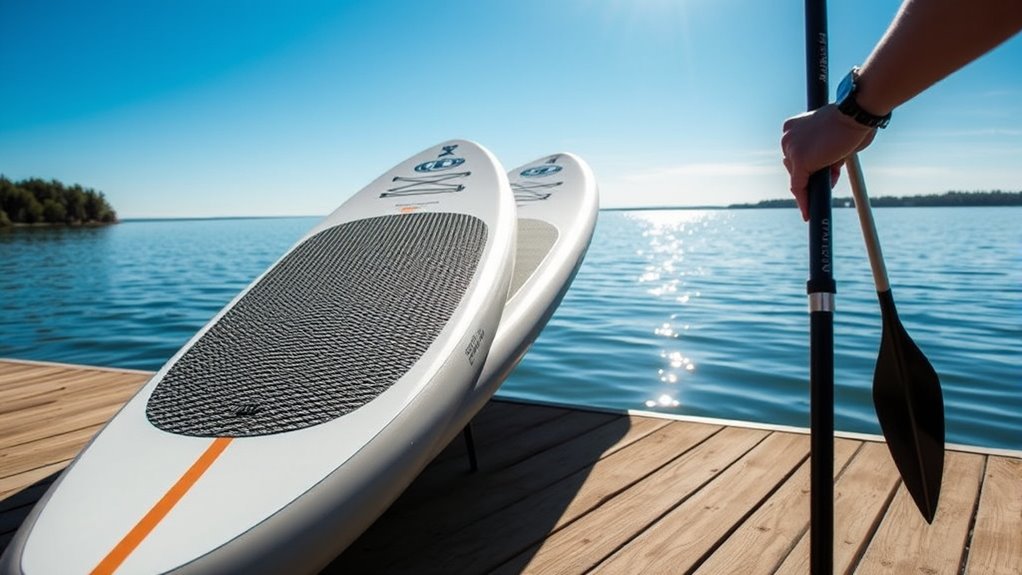
Balancing your budget with quality and durability is essential to getting the most value from your stand-up paddleboard. If you’re exploring budget options, you can still find boards that offer good performance and longevity without overspending. Cheaper models often use basic materials, but some brands provide affordable options with decent durability. However, investing in a paddleboard with premium quality materials may cost more upfront but pays off in the long run through increased lifespan and better performance. Consider your intended use and frequency of paddling to determine the right balance. Remember, a slightly higher initial investment can mean fewer replacements and repairs down the road, ensuring you enjoy your time on the water with a reliable, durable board.
Testing and Trying Out Paddleboards Before Buying
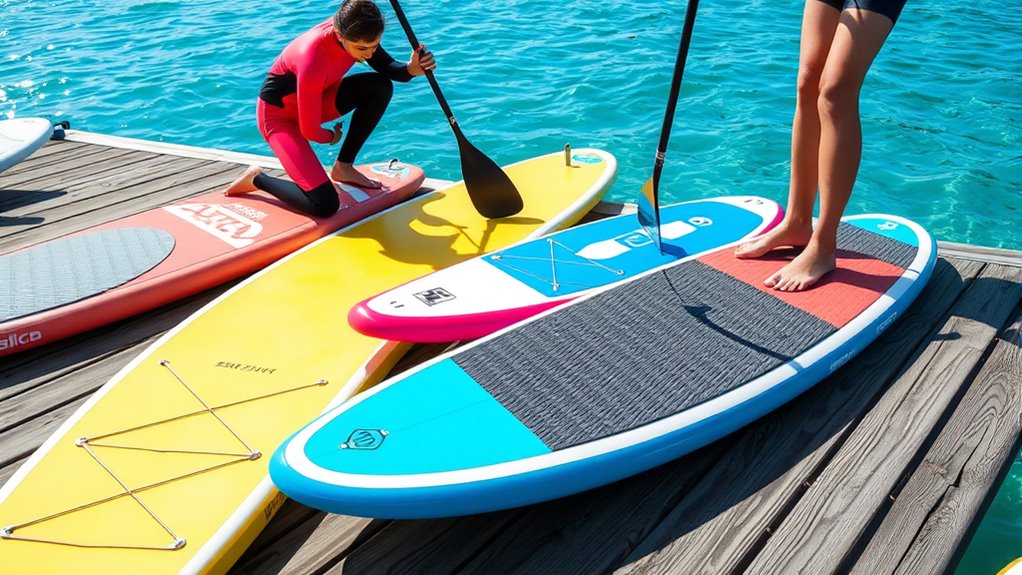
Before you make a purchase, it’s crucial to test how a paddleboard feels in your hands. Focus on its stability and how well you can balance, and try controlling it in different water conditions. This hands-on approach helps ensure you choose a board that matches your skill level and riding style.
Check Stability and Balance
Since stability is crucial for a confident paddling experience, it’s essential to test how well a paddleboard balances before making a purchase. Focus on your balance techniques and how the stability features support you. Stand on the board and gently shift your weight side to side to gauge responsiveness. Feel for wobbling or tipping, which indicates less stability. Check the width and length of the board; wider and longer boards generally offer better balance for beginners. Keep in mind that materials and construction also influence stability. To assess, try the board in different conditions if possible, such as calm water. This hands-on approach helps you find a paddleboard that feels secure and confident for your skill level and paddling style.
- Test responsiveness by shifting your weight gradually
- Observe how the board reacts to small movements
- Consider width, length, and stability features for your needs
Assess Maneuverability and Control
Evaluating maneuverability and control is essential to guarantee you can steer and handle your paddleboard confidently. To test handling responsiveness, try quick turns and smooth pivots. Feel how easily the board responds to your movements—this reflects its maneuverability control. A board with good handling should feel lively yet predictable, letting you navigate waves and tight spots effortlessly. Consider these aspects during demos:
| Maneuverability | Control | Handling Responsiveness |
|---|---|---|
| Quick turns | Precise steering | Agile and responsive |
| Easy pivots | Stable at speed | Reactive to shifts |
| Sharp maneuvers | Smooth tracking | Confident handling |
Picking the right balance ensures you’ll enjoy stability without sacrificing agility, making every ride both fun and safe.
Try Different Water Conditions
Trying out your paddleboard in various water conditions is essential to guarantee it performs well in real-world situations. Different water conditions, from calm lakes to choppy surf, test your board’s stability and handling. This experience also helps you assess water safety and how easy it is to maneuver in diverse environments. When testing, consider how your paddleboard responds to waves, wind, and currents. Also, think about paddleboard storage options if you plan to transport it frequently or store it outdoors, as some boards are better suited for different conditions.
- Test on calm water, then challenge yourself with choppier conditions
- Observe how easily you can control and turn the board
- Ensure your board feels stable and secure in various scenarios
Tips for Maintaining and Caring for Your Paddleboard
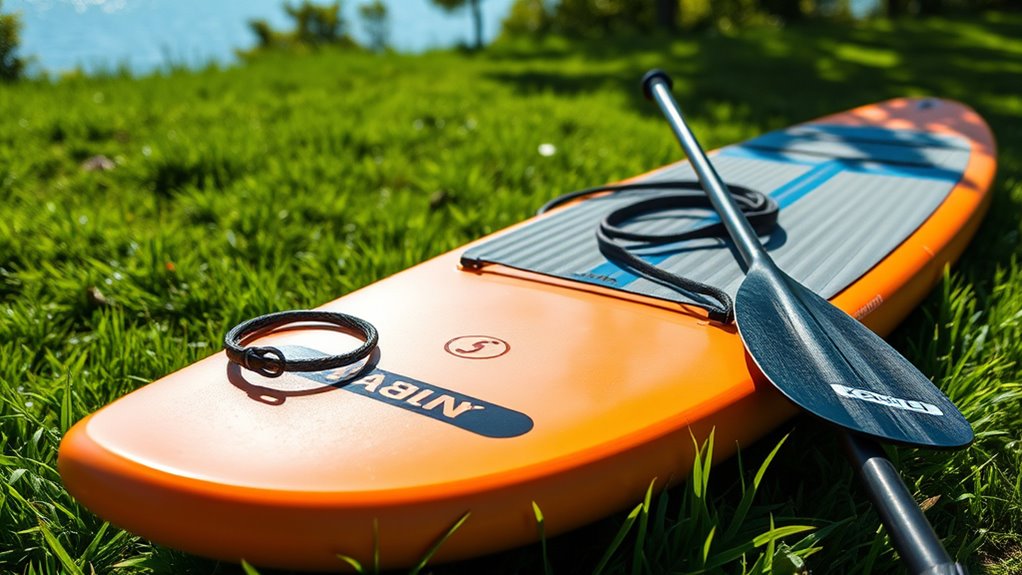
To keep your paddleboard in top condition, regular maintenance is essential. Start with paddleboard cleaning after each use to remove dirt, salt, and debris that can degrade the material. Use a mild soap and freshwater, avoiding harsh chemicals that can damage the surface. Proper storage tips are equally important; store your board in a cool, shaded area away from direct sunlight to prevent warping or fading. Keep it off the ground or use a rack to avoid pressure points and dents. Rinse and dry your paddleboard thoroughly before storing it to prevent mold and mildew. Regular inspections for dings or cracks will help you catch damage early, ensuring your board remains durable and safe for future adventures.
Frequently Asked Questions
How Do I Transport My Paddleboard Effectively?
To transport your paddleboard effectively, use carrying straps for easier carrying and balance. When driving, secure your board on roof racks to prevent movement and damage. Make sure the board is tightly strapped and supported on the rack, avoiding any loose ends. If you’re walking, carry the board with straps over your shoulder for comfort. Properly anchoring your paddleboard ensures safe and hassle-free transportation to your favorite water spot.
What Safety Gear Should I Use With My Paddleboard?
When paddleboarding, you should prioritize safety by using essential paddleboard accessories like a life jacket, leash, and whistle. These safety precautions help prevent accidents and make sure you’re prepared for emergencies. Always check your gear before heading out, and consider weather conditions. Wearing a leash keeps you connected to your board, while a life jacket provides buoyancy. These safety measures let you enjoy your paddleboarding experience confidently and responsibly.
How Do Weather Conditions Affect Paddleboarding?
Imagine you’re sailing a tiny boat on a vast, open sea. When wind speed picks up, it’s like nature’s playful giant stirring the waters, creating larger wave heights that can toss you around. Calm winds mean smoother rides, while strong gusts challenge your balance. Always check the weather first; high wind speeds and increased wave heights can make paddleboarding risky. Be prepared, and respect the sea’s mood.
Can I Use a Paddleboard in Saltwater and Freshwater?
You can definitely use your paddleboard in both saltwater and freshwater. Just remember, after each use, especially in saltwater, rinse your board with fresh water to prevent corrosion. Regular paddleboard maintenance extends its lifespan. Using the right paddleboard accessories, like a leash and a fin, enhances your experience and keeps your board secure. Whether in lakes or oceans, your paddleboard is versatile and ready for adventure with proper care.
How Often Should I Inspect My Paddleboard for Damage?
Your paddleboard is practically a treasure, so you should examine it regularly—at least once a month, or after heavy use or rough conditions. This routine board maintenance helps catch damage early and prevents costly repairs. Check for cracks, dings, or delamination, especially in high-impact areas. Consistent inspections ensure your board stays in top shape, making damage prevention easier and extending its lifespan for countless adventures.
Conclusion
Choosing the right paddleboard is like finding a trusty companion for your adventures on the water. By understanding the different types, sizes, and features, you’ll be equipped to make a confident pick. Remember, your perfect board is out there waiting—ready to support your journey and help you glide smoothly through every wave. Trust your instincts, test different options, and soon you’ll be riding the currents like a seasoned pro. Your aquatic adventure starts now!



